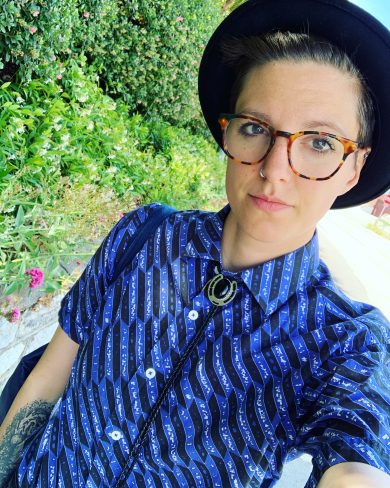Grad Profile: Kirstin Wagner
 Kirstin Wagner is a PhD Student in the Literature Department. Wagner’s dissertation project Daughter in Waves: Matrilineal Inheritance and the Poetics of Violence explores memories of family history, violence, trauma, and the process by which these memories continue or are erased, if incompletely.
Kirstin Wagner is a PhD Student in the Literature Department. Wagner’s dissertation project Daughter in Waves: Matrilineal Inheritance and the Poetics of Violence explores memories of family history, violence, trauma, and the process by which these memories continue or are erased, if incompletely.
In January, we spoke with Wagner about her ongoing dissertation work and the wide array of THI programs she has participated in over the course of her graduate career. Wagner was a 2018-19 Public Fellow, a Teaching Fellow for THI’s Questions That Matter series in 2020, and has also worked in multiple capacities with other graduate students, such as the Graduate Student Success Program.
Good morning, Kirstin! Thank you for taking the time to talk with us about your ongoing research and academic activities. To begin, can you give us a bird’s-eye description of your dissertation project?
Thanks for the opportunity to share a bit about my work. My dissertation, Daughter in Waves: Matrilineal Inheritance and the Poetics of Violence, is an autotheoretical family history of inherited trauma. I weave together critical essays on trauma, memory, and embodiment with family stories, speculative memoir, and poems to create a kaleidoscopic rendering of domestic abuse and resistance across three generations of my family. This multivocal form builds surprising passageways between the experiential fragments, deferred emotions, and compromised memories that comprise familial trauma, all the while unsettling false dichotomies such as victim/perpetrator and truth/fiction. The text both traces the formation of my subjective self as a queer daughter who has inherited certain kinds of violence, and positions my family’s experiences within larger histories of domestic violence, immigration, and feminist resistance. As a narrative intervention in embodied healing practices, Daughter in Waves poses a series of questions about the challenges of speaking from an incomplete or actively erased archive of familial memory: How can we tell the story of a family who doesn’t tell the stories of its violence? What stories are inherited and taken to be true and why? Where do fact and fiction intersect/overlap/converge in recounting violence? What does it mean to speak from a traumatized body? By demonstrating the importance of creative, critical, collaborative, and speculative approaches to healing from traumatic experiences, my project enhances an important conversation around the uses of autotheory to collapse the conceptual binary of research/imagination and reanimate embodied subjectivity in projects engaging histories of trauma.
That sounds so interesting! Have you encountered any challenges using your own creative writing in your dissertation?
Central to my project is the argument that the physical, graphic details of embodied life are just as integral for theorizing domestic abuse as the critical theory that guides academic discussions. So incorporating more “creative” elements into my work comes naturally to me as a way to animate the materiality of my own body and the bodies of the women in my life and across history whose stories turn on their abuse. This is why I work predominantly in autotheory, an interdisciplinary feminist practice that weaves together autobiographical material with philosophy, theory, and criticism. Autotheoretical writing has allowed me to unite my doctoral training in feminist studies and trauma studies with my creative practice in embodied writing, in order to analyze the political and affective inheritances that both constrain and empower survivors of gender-based violence. Inviting creative writing into my dissertation project has also meant taking what Mel Chen would call a “feral” approach to disciplinarity, making use of an expansive archive of materials including genetic data, family photographs, oral histories, physical objects, and measurements of mood and affect discerned over decades spent with the women in my family. This archive allows me to detail both the intergenerational effects of trauma on the body and the relationship between idiosyncratic family stories and generalized social constructions of gender. By rooting the study of domestic violence in the body, my project opens dialogues with feminist somatic healing practices to consider how theoretical approaches to trauma can be expanded and enriched by taking creative, speculative approaches to physical experiences of violence.
Themes of the body, violence, memory, and the difficulty of narrating trauma that animate your dissertation also seem to influence your pedagogy. How does your research inform your teaching practice and course design, particularly with topics that are difficult to discuss and write about?
Thanks for this question. Because I am thinking, always, about the body, my pedagogy is deeply invested in embodiment. Learning is a somatic process as much as it is an intellectual one. Since my courses often address themes and topics that are controversial and intimate, it is not my goal to avoid discomfort. Rather, I seek to aid students in managing their discomfort and pushing up against their intellectual and emotional boundaries as skills-building acts of growth and critical empathy. Trauma studies teaches that our bodies and brains share responsibility for creating conditions that make learning and connecting with others possible. In order to facilitate learning at sites of discomfort, I provide opportunities for students to slow down, feel into their bodies, and share both somatic insights and intellectual areas of stuckness or interest. We engage in nervous system regulation exercises, meditation, and other contemplative activities to help students connect with their bodies as crucial sites of knowledge. As I tell my students, listening—to our bodies, to one another, to what a piece of writing has to say—is a creative and critical practice that requires patience, generosity, and the extension of our compassion and curiosity instead of our egos.
While we’re on the topic of pedagogy, I wanted to hear more about your experience working with other graduate students to improve teaching practices. You focused on graduate pedagogy as a Graduate Student Researcher (GSR) at UC Santa Cruz’s Center for Innovations in Teaching and Learning and you were a fellow at the National Humanities Center’s 2020 Graduate Student Summer Program on “Passionate Teaching in the Research Environment: How to Create Meaningful Online Learning Experiences.” How have your collaborations with other graduate students and peer mentor positions enhanced your teaching and challenged you as an educator?
Working with other graduate students on pedagogy has been a highlight of my time at UCSC.
Working with other graduate students on pedagogy has been a highlight of my time at UCSC. I was lucky enough to serve as a Graduate Pedagogy Fellow for the Literature department in 2019 and as a Teaching Fellow for THI’s Questions That Matter program in 2020, both experiences which brought me into collaboration with other graduate students who were thinking about equitable course design and inclusive classroom practices. I have learned so much from my colleagues, especially those hailing from other disciplines, whose insights about instruction helped me to think differently about the ways we approach teaching and learning in the humanities. Working as a peer mentor has always felt to me like a horizontal exchange, and I am so grateful to the graduate student summer instructors I mentored, as well as those I worked with through the Questions That Matter and Graduate Student Success Programs, for their curiosity, vulnerability, and ingenuity. What I’ve learned from our conversations and collaborations is that pedagogical practice is ever-evolving, and the more willing we are as instructors to be self-reflexive about our values, biases, strengths, weaknesses, and our own vulnerabilities, the better we can show up to the classroom honestly and responsibly. Working with other graduate students has helped me take seriously the power and authority afforded me as an instructor, and encouraged me to use my position in the classroom to intervene in the harmful power dynamics and homogenizing cultural narratives that are structurally endemic to academic spaces.
Finally, I wonder how you envision academics reaching diverse publics outside of the university. You were a 2018-19 THI Public Fellow at the Catamaran Literary Reader. How did that experience help you formulate your own sense of what publicly engaged scholarship can and should look like?
My time at Catamaran was wonderful. I am incredibly grateful to Catherine Segurson, my mentor at Catamaran, for teaching me the ins and outs of the literary journal world, and to the many UCSC undergraduate interns with whom I had the pleasure of working over two years. A highlight from my time with Catamaran was serving as the manager of the Catamaran Writing Conference in the summer of 2017, where I had the opportunity to meet conference participants, host visiting writers, and learn what a monumental, communal effort it is to build such a passionate, engaged, ephemeral writing community.
I have been thinking a lot about what it means to be a “publicly engaged” scholar and for me, that effort is really rooted in continued community activism.
I have been thinking a lot about what it means to be a “publicly engaged” scholar and for me, that effort is really rooted in continued community activism. Writing about domestic violence is important work, but so is the task of actively combatting sexual harassment and sexual violence (SVSH) in the spaces we expect to be safe, whether it be at home, on campus, at work, or in other public settings. I have volunteered in women’s shelters in three cities, and I can’t say enough how humbled I have been by the immense resilience, creativity, courage, and strength I’ve witnessed in those spaces. Spending time in those communities reminds me that what I write is never contained on the page, but draws from and bears out into the lives of real people who are suffering, surviving, thriving. I have also had the great fortune of participating in a graduate student learning community for Beyond Compliance where we designed curricular units around SVSH content and shared pedagogical strategies for responsibly teaching sensitive material in undergraduate classrooms. I am infinitely grateful to Alison Hanson, the CARE Prevention Education Coordinator, and Kendra Dority, the Associate Director of Graduate Programs at CITL, who facilitated those conversations. That experience made clear to me that college campuses are especially potent sites to do this work and to normalize conversations around consent and body autonomy. For me, being a “publicly engaged scholar” means attuning to the needs and vulnerabilities of those around me, building communities of care beyond the page, and making equity work a collaborative liberatory praxis rooted in dialogue and listening.
